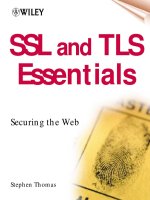SSL and TLS Essentials Securing the Web phần 1 pptx
Bạn đang xem bản rút gọn của tài liệu. Xem và tải ngay bản đầy đủ của tài liệu tại đây (1.48 MB, 22 trang )
SSL and TLS
Essentials
Securing the Web
Stephen Thomas
SSL & TLS Essentials
Securing the Web
Stephen A. Thomas
Wiley Computer Publishing
John Wiley & Sons, Inc.
New York •
••
• Chichester •
••
• Weinheim •
••
• Brisbane •
••
• Singapore •
••
• Toronto
Publisher: Robert Ipsen
Editor: Marjorie Spencer
Assistant Editor: Margaret Hendrey
Text Design & Composition: Stephen Thomas
Designations used by companies to distinguish their products are often claimed as
trademarks. In all instances where John Wiley & Sons, Inc., is aware of a claim, the
product names appear in initial capital or all capital letters. Readers, however,
should contact the appropriate companies for more complete information regarding
trademarks and registration.
This book is printed on acid-free paper.
Copyright © 2000 by Stephen A. Thomas. All rights reserved.
Published by John Wiley & Sons, Inc.
Published simultaneously in Canada.
No part of this publication may be reproduced, stored in a retrieval system or trans-
mitted in any form or by any means, electronic, mechanical, photocopying, re-
cording, scanning or otherwise, except as permitted under Section 107 or 108 of the
1976 United States Copyright Act, without either the prior written permission of the
Publisher, or authorization through payment of the appropriate per-copy fee to the
Copyright Clearance Center, 222 Rosewood Drive, Danvers, ma 01923, (978) 750-
8400, fax (978) 750-4744. Requests to the Publisher for permission should be ad-
dressed to the Permissions Department, John Wiley & Sons, Inc., 605 Third Avenue,
New York, ny 10158-0012, (212) 850-6011, fax (212) 850-6008, email perm-
This publication is designed to provide accurate and authoritative information in re-
gard to the subject matter covered. It is sold with the understanding that the pub-
lisher is not engaged in professional services. If professional advice or other expert
assistance is required, the services of a competent professional person should be
sought.
Library of Congress Cataloging-in-Publication Data:
Thomas, Stephen A., 1962-
ssl and tls essentials : securing the Web / Stephen A. Thomas.
p. cm.
Includes index.
isbn 0-471-38354-6 (pbk./cd-rom : alk. paper)
1. Computer networks Security measures. 2. World Wide Web Security
measures. 3. Computer network protocols. I. Title.
tk5105.59 .t49 2000
005.8 dc21 99-058910
Printed in the United States of America.
10 9 8 7 6 5 4 3 2 1
For Kelsie,
Zookeeper of Mango the Flamingo.
ix
Contents
Chapter 1: Introduction 1
1.1 Web Security and Electronic Commerce 2
1.2 History of ssl and tls 4
1.3 Approaches to Network Security 6
1.3.1 Separate Security Protocol 8
1.3.2 Application-Specific Security 9
1.3.3 Security within Core Protocols 10
1.3.4 Parallel Security Protocol 11
1.4 Protocol Limitations 12
1.4.1 Fundamental Protocol Limitations 12
1.4.2 Tool Limitations 13
1.4.3 Environmental Limitations 14
1.5 Organization of This Book 14
Chapter 2: Basic Cryptography 17
2.1 Using Cryptography 18
2.1.1 Keeping Secrets 18
2.1.2 Proving Identity 19
2.1.3 Verifying Information 20
2.2 Types of Cryptography 21
2.2.1 Secret Key Cryptography 22
2.2.2 Public Key Cryptography 24
2.2.3 Combining Secret & Public Key Cryptography 27
2.3 Key Management 29
2.3.1 Public Key Certificates 29
2.3.2 Certificate Authorities 31
2.3.3 Certificate Hierarchies 33
2.3.4 Certificate Revocation Lists 35
x SSL & TLS Essentials: Securing the Web
Chapter 3: SSL Operation 37
3.1 SSL Roles 37
3.2 SSL Messages 38
3.3 Establishing Encrypted Communications 39
3.3.1 ClientHello 41
3.3.2 ServerHello 43
3.3.3 ServerKeyExchange 45
3.3.4 ServerHelloDone 45
3.3.5 ClientKeyExchange 45
3.3.6 ChangeCipherSpec 46
3.3.7 Finished 51
3.4 Ending Secure Communications 52
3.5 Authenticating the Server’s Identity 52
3.5.1 Certificate 55
3.5.2 ClientKeyExchange 56
3.6 Separating Encryption from Authentication 56
3.6.1 Certificate 59
3.6.2 ServerKeyExchange 59
3.6.3 ClientKeyExchange 59
3.7 Authenticating the Client’s Identity 60
3.7.1 CertificateRequest 61
3.7.2 Certificate 62
3.7.3 CertificateVerify 63
3.8 Resuming a Previous Session 64
Chapter 4: Message Formats 67
4.1 Transport Requirements 68
4.2 Record Layer 69
4.3 ChangeCipherSpec Protocol 71
4.4 Alert Protocol 72
4.4.1 Severity Level 72
4.4.2 Alert Description 73
4.5 Handshake Protocol 74
4.5.1 HelloRequest 76
4.5.2 ClientHello 77
Contents xi
4.5.3 ServerHello 79
4.5.4 Certificate 80
4.5.5 ServerKeyExchange 81
4.5.6 CertificateRequest 84
4.5.7 ServerHelloDone 85
4.5.8 ClientKeyExchange 85
4.5.9 CertificateVerify 88
4.5.10 Finished 90
4.6 Securing Messages 92
4.6.1 Message Authentication Code 93
4.6.2 Encryption 95
4.6.3 Creating Cryptographic Parameters 96
4.7 Cipher Suites 102
4.7.1 Key Exchange Algorithms 103
4.7.2 Encryption Algorithms 104
4.7.3 Hash Algorithms 104
Chapter 5: Advanced SSL 105
5.1 Compatibility with Previous Versions 105
5.1.1 Negotiating ssl Versions 106
5.1.2 SSL Version 2.0 ClientHello 109
5.1.3 SSL Version 2.0 Cipher Suites 110
5.2 Netscape International Step-Up 111
5.2.1 Server Components 112
5.2.2 Client Components 112
5.2.3 Controlling Full-Strength Encryption 113
5.3 Microsoft Server Gated Cryptography 115
5.3.1 Server Gated Cryptography Certificates 115
5.3.2 Cipher Suite Renegotiation 115
5.4 The Transport Layer Security Protocol 117
5.4.1 TLS Protocol Version 118
5.4.2 Alert Protocol Message Types 118
5.4.3 Message Authentication 121
5.4.4 Key Material Generation 123
5.4.5 CertificateVerify 125
5.4.6 Finished 126
xii SSL & TLS Essentials: Securing the Web
5.4.7 Baseline Cipher Suites 126
5.4.8 Interoperability with SSL 128
5.5 The Future of ssl and tls 128
Appendix A: X.509 Certificates 131
A.1 X.509 Certificate Overview 132
A.1.1 Version 132
A.1.2 Serial Number 133
A.1.3 Algorithm Identifier 133
A.1.4 Issuer 133
A.1.5 Period of Validity 133
A.1.6 Subject 134
A.1.7 Subject’s Public Key 134
A.1.8 Issuer Unique Identifier 134
A.1.9 Subject Unique Identifier 134
A.1.10 Extensions 135
A.1.11 Signature 135
A.2 Abstract Syntax Notation One 135
A.2.1 Primitive Objects 136
A.2.2 Constructed Objects 136
A.2.3 The Object Identifier Hierarchy 137
A.2.4 Tagging 139
A.2.5 Encoding Rules 142
A.3 X.509 Certificate Definition 145
A.3.1 The Certificate Object 145
A.3.2 The Version Object 146
A.3.3 The CertificateSerialNumber Object 147
A.3.4 The AlgorithmIdentifier Object 147
A.3.5 The Validity Object 148
A.3.6 The SubjectPublicKeyInfo Object 148
A.3.7 The Time Object 149
A.3.8 The Extensions Object 149
A.3.9 The UniqueIdentifier Object 150
A.3.10 The Name Object 150
A.4 Example Certificate 152
Contents xiii
Appendix B: SSL Security Checklist 161
B.1 Authentication Issues 161
B.1.1 Certificate Authority 162
B.1.2 Certificate Signature 163
B.1.3 Certificate Validity Times 163
B.1.4 Certificate Revocation Status 163
B.1.5 Certificate Subject 163
B.1.6 Diffie-Hellman Trapdoors 164
B.1.7 Algorithm Rollback 164
B.1.8 Dropped ChangeCipherSpec Messages 165
B.2 Encryption Issues 166
B.2.1 Encryption Key Size 166
B.2.2 Traffic Analysis 167
B.2.3 The Bleichenbacher Attack 168
B.3 General Issues 170
B.3.1 RSA Key Size 170
B.3.2 Version Rollback Attacks 171
B.3.3 Premature Closure 171
B.3.4 SessionID Values 172
B.3.5 Random Number Generation 172
B.3.6 Random Number Seeding 173
References 175
Protocol Standards 175
Certificate Formats 176
Cryptographic Algorithms 177
SSL Implementations 178
Glossary 179
Index 191
1
1
Introduction
Today alone, Dell Computer will sell more than $18 million worth of
computer equipment through the Internet. In
1999, nine million
Americans traded stocks online, accounting for one-third of all retail
stock trades. And more than 200,000 Web sites worldwide (includ-
ing sites belonging to 98 of the Fortune
100) can accept e-commerce
transactions. Commercial use of the Web continues to grow at an as-
tonishing pace, and securing Web transactions has become increas-
ingly critical to businesses, organizations, and individual users.
Fortunately, an extremely effective and widely deployed communica-
tions protocol provides exactly that security. It is the Secure Sockets
Layer protocol, more commonly known simply as ssl. The ssl pro-
tocol—along with its successor, the Transport Layer Security (tls)
protocol—is the subject of this book.
This chapter introduces ssl and tls, and provides the essential con-
text for both. It begins with a very brief look at Web security and
electronic commerce, focusing on the issues that led to the creation
of ssl. The next section follows up with a quick history of ssl and its
transformation into tls. The relationship of ssl to other network se-
curity technologies is the subject of the third section. The forth sec-
tion, “Protocol Limitations,” is an important one. Especially with
security technologies, it is critical to understand what they cannot do.
The chapter closes with an overview of the rest of this book.
2 SSL & TLS Essentials: Securing the Web
1.1 Web Security and Electronic Commerce
Know the enemy. Sun Tzu could not have offered any advice more ap-
propriate to security professionals. Specific security services are nec-
essarily effective against only specific threats; they may be completely
inappropriate for other security threats. To understand ssl, therefore,
it is essential to understand the environment for which it has been
designed.
Even though ssl is a flexible protocol that is finding use in many dif-
ferent applications, the original motivation for its development was
the Internet. The protocol’s designers needed to secure electronic
commerce and other Web transactions. That environment is certainly
perilous enough. Consider, for example, what happens when a user in
Berlin places an online order from a Web site in San Jose, California.
Table
1-1 lists the systems through which the user’s messages might
pass.
Table 1-1 Internet Systems in Path from Berlin to San Jose
Step IP Address
System Name (if known)
1
212.211.70.7
2
212.211.70.254
3
195.232.91.66
fra-ppp2-fas1-0-0.wan.wcom.net
4
212.211.30.29
5
206.175.73.45
hil-border1-atm4-0-2.wan.wcom.net
6
205.156.223.41
dub-border1-hss2-0.wan.wcom.net
7
204.70.98.101
borderx1-hssi2-0.northroyalton.cw.net
8
204.70.98.49
core2-fddi-0.northroyalton.cw.net
9
204.70.9.138
corerouter1.westorange.cw.net
10
204.70.4.101
core5.westorange.cw.net
11
204.70.10.230
sprint4-nap.westorange.cw.net
12
192.157.69.85
sprint-nap.home.net
13
24.7.72.113
c1-pos9-1.cmdnnj1.home.net
14
24.7.67.153
c1-pos6-2.clevoh1.home.net
15
24.7.64.173
c1-pos3-0.chcgil1.home.net
16
24.7.64.141
c1-pos1-0.omahne1.home.net
Introduction 3
Step IP Address
System Name (if known)
17
24.7.66.173
c1-pos8-3.lnmtco1.home.net
18
24.7.64.57
c1-pos1-0.slkcut1.home.net
19
24.7.66.77
c1-pos5-3.snjsca1.home.net
20
24.7.72.18
bb1-pos6-0-0.rdc1.sfba.home.net
21
172.16.6.194
22
10.252.84.3
23
10.252.10.150
24
209.219.157.152
www.sj-downtown.com
Figure 1-1 highlights the fact that messages containing the user’s in-
formation, including sensitive information such as credit card num-
bers, may travel a complex path from Germany to California,
crossing through many countries, over various networks, and on
many different facilities. Some of those facilities are likely to belong
to private enterprises, many of which are not subject to any regula-
tion or other laws governing the privacy of the information they
transport.
Neither the user nor the Web server has any control over the path
their messages take, nor can they control who examines the message
contents along the route. From a security standpoint, it’s as if the
user wrote her credit card number on a postcard and then delivered
Web Server
Web Browser
Figure 1-1 Messages travel complex paths through the Internet.
4 SSL & TLS Essentials: Securing the Web
the postcard as a message in a bottle. The user has no control over
how the message reaches its destination, and anyone along the way
can easily read its contents. Electronic commerce cannot thrive in
such an insecure environment; sensitive information must be kept
confidential as it traverses the Internet.
Eavesdropping isn’t the only security threat to Web users. It is theo-
retically possible to divert Web messages to a counterfeit Web site.
Such a counterfeit site could provide false information, collect data
such as credit card numbers with impunity, or create other mischief.
1
The Internet needs a way to assure users of a Web site’s true identity;
likewise, many Web sites need to verify the identity of their users.
A final security challenge facing Web users is message integrity. A
user placing an online stock trade certainly wouldn’t want his
instructions garbled in such a way as to change “Sell when the price
reaches $200” to “Sell when the price reaches $20.” The missing zero
can make a significant difference in the user’s fortunes.
1.2 History of SSL and TLS
Fortunately, engineers were thinking about these security issues from
the Web’s beginnings. Netscape Communications began considering
Web security while developing its very first Web browser. To address
the concerns of the previous section, Netscape designed the Secure
Sockets Layer protocol.
Figure
1-2 shows the evolution of ssl in the context of general Web
development. The timeline begins in November
1993, with the release
of Mosaic
1.0 by the National Center for Supercomputing Applica-
tions (ncsa). Mosaic was the first popular Web browser. Only eight
months later, Netscape Communications completed the design for
_________________
1
This security threat isn’t unique to the Web. In Computer-Related Risks (Addison-
Wesley, 1995), Peter G. Neumann recounts the story of two criminals who set up a
bogus atm in a Connecticut mall. The machine didn’t dispense much cash, but it
did capture the account number and pin of unsuspecting victims. The crooks then
fabricated phony atm cards and allegedly withdrew over $100 000.
Introduction 5
ssl version
1.0; five months after that, Netscape shipped the first
product with support for ssl version 2.0—Netscape Navigator.
Other milestones in the timeline include the publication of version
1.0 of the Private Communication Technology (pct) specification.
Microsoft developed pct as a minor enhancement to ssl version 2.0.
It addressed some of the weaknesses of ssl 2.0, and many of its ideas
were later incorporated into ssl version 3.0.
The later events on the timeline represent a shift in focus for the ssl
standard. Netscape Communications developed the first three ver-
sions of ssl with significant assistance from the Web community. Al-
though ssl’s development was open, and Netscape encouraged others
in the industry to participate, the protocol technically belonged to
Netscape. (Indeed, Netscape has been granted a u.s. patent for ssl.)
Beginning in May
1996, however, ssl development became the re-
sponsibility of an international standards organization—the Internet
Engineering Task Force (ietf). The ietf develops many of the pro-
tocol standards for the Internet, including, for example, tcp and ip.
SSL 1.0
design complete
1993
1994
1995
1996
1997
1998
1999
SSL 2.0
product ships
PCT 1.0
published
SSL 3.0
published
TLS 1.0
published
TLS WG
formed
NCSA
Mosaic
released
Netscape
Navigator
released
Internet
Explorer
released
Figure 1-2 SSL was developed along with early Web browsers.
6 SSL & TLS Essentials: Securing the Web
SSL vs. TLS
Because
SSL is
more widely
used and much
better known
than
TLS, the
main text of this
book describes
SSL rather than
TLS. The differ-
ences between
the two are very
minor, however.
Sidebars such as
this one will note
all those differ-
ences.
To avoid the appearance of bias toward any particular company, the
ietf renamed ssl to Transport Layer Security (tls). The final version
of the first official tls specification was released in January
1999.
Despite the change of names, tls is nothing more than a new ver-
sion of ssl. In fact, there are far fewer differences between tls
1.0
and ssl 3.0 than there are between ssl 3.0 and ssl 2.0. Section 5.4
details the differences between ssl and tls, but check the sidebars
for more information.
Support for ssl is now built in to nearly all browsers and Web serv-
ers. For users of Netscape Navigator or Microsoft’s Internet Explorer,
ssl operates nearly transparently. Observant users might notice the
“https:” prefix for an ssl-secured url, or they may see a small icon
that each browser displays when ssl is in use. (Figure
1-3 shows the
padlock symbol that Internet Explorer displays in the bottom status
bar; Navigator shows a similar icon.) For the most part, however, ssl
simply works, safely providing confidentiality, authentication, and
message integrity to its Web users.
Today’s popular Web servers also include support for ssl. It’s usually
a simple task to enable ssl in the server. As we’ll see, though, to sup-
port secure Web browsing, a Web server must do more than simply
enable the ssl protocol. The server must also obtain a public key cer-
tificate from an organization that Web browsers trust. For users on
the public Internet, those organizations are generally public certifi-
cate authorities. Popular certificate authorities include at&t Certifi-
cate Services, gte CyberTrust, KeyWitness International, Microsoft,
Thawte Consulting, and VeriSign. The next chapter includes further
discussions of certificate authorities (primarily in section 2.3.2), and
appendix a provides details on public key certificates.
1.3 Approaches to Network Security
The Secure Sockets Layer protocol provides effective security for
Web transactions, but it is not the only possible approach. The Inter-
net architecture relies on layers of protocols, each building on the
services of those below it. Many of these different protocol layers can
Introduction 7
support security services, though each has its own advantages and
disadvantages. As we’ll see in this section, the designers of ssl chose
to create an entirely new protocol layer for security. It is also possible
to include security services in the application protocol or to add them
to a core networking protocol. As another alternative, applications
can rely on parallel protocols for some security services. All of these
options have been considered for securing Web transactions, and ac-
tual protocols exist for each alternative. Table
1-2 summarizes the ad-
vantages of each approach, and this section considers each of the
possible approaches in more detail.
Table 1-2 Different Approaches to Network Security
Protocol Architecture Example A B C D E
Separate Protocol Layer SSL
ⅷ ⅷ ⅜ ⅜ ⅷ
Application Layer S-HTTP
ⅷ ⅜ ⅷ ⅜ ⅷ
Integrated with Core
IPSEC
ⅷ ⅷ ⅜ ⅷ ⅜
Parallel Protocol Kerberos
⅜ ⅷ ⅜ ⅜ ⅷ
Benefits: A – Full Security B – Multiple Applications C – Tailored Services
D – Transparent to Application E – Easy to Deploy
Figure 1-3 Web browsers such as Internet Explorer include
SSL.
8 SSL & TLS Essentials: Securing the Web
1.3.1 Separate Security Protocol
The designers of the Secure Sockets Layer decided to create a sepa-
rate protocol just for security. In effect, they added a layer to the
Internet’s protocol architecture. The left side of figure
1-4 shows the
key protocols for Web communications. At the bottom is the Inter-
net Protocol (ip). This protocol is responsible for routing messages
across networks from their source to their destination. The Transmis-
sion Control Protocol (tcp) builds on the services of ip to ensure
that the communication is reliable. At the top is the Hypertext
Transfer Protocol; http understands the details of the interaction
between Web browsers and Web servers.
As the right side of the figure indicates, ssl adds security by acting as
a separate security protocol, inserting itself between the http appli-
cation and tcp. By acting as a new protocol, ssl requires very few
changes in the protocols above and below. The http application in-
terfaces with ssl nearly the same way it would with tcp in the ab-
sence of security. And, as far as tcp is concerned, ssl is just another
application using its services.
In addition to requiring minimal changes to existing implementa-
tions, this approach has another significant benefit: It allows ssl to
support applications other than http. The main motivation behind
the development of ssl was Web security, but, as figure
1-5 shows, ssl
HTTP
IP
TCP
HTTP
IP
TCP
SSL
Not Secure
Secure
Figure 1-4 SSL is a separate protocol layer just for security.
Introduction 9
is also used to add security to other Internet applications, including
those of the Net News Transfer Protocol (nntp) and the File Trans-
fer Protocol (ftp).
1.3.2 Application-Specific Security
Although the designers of ssl chose a different strategy, it is also
possible to add security services directly in an application protocol.
Indeed, standard http does include some extremely rudimentary se-
curity features; however, those security features don’t provide ade-
quate protection for real electronic commerce. At about the same
time Netscape was designing ssl, another group of protocol design-
ers was working on an enhancement to http known as Secure http.
Figure
1-6 shows the resulting protocol architecture. The Secure
http standard has been published by the ietf as an experimental
HTTP
IP
TCP
SSL
NNTP
FTP
Figure 1-5 SSL can add security to applications other than
HTTP.
security
IP
TCP
HTTP
IP
TCP
Not Secure
Secure
HTTP
Figure 1-6 Security can be added directly within an application protocol.
10 SSL & TLS Essentials: Securing the Web
protocol, and a few products support it. It never caught on to the
same degree as ssl, however, and oday it is rare to find Secure http
anywhere on the Internet.
One of the disadvantages of adding security to a specific application
is that the security services are available only to that particular appli-
cation. Unlike ssl, for example, it is not possible to secure nntp, ftp,
or other application protocols with Secure http. Another disadvan-
tage of this approach is that it ties the security services tightly to the
application. Every time the application protocol changes, the security
implications must be carefully considered, and, frequently, the secu-
rity functions of the protocol must be modified as well. A separate
protocol like ssl isolates security services from the application proto-
col, allowing each to concentrate on solving its own problems most
effectively.
1.3.3 Security within Core Protocols
The separate protocol approach of ssl can be taken one step further
if security services are added directly to a core networking protocol.
That is exactly the approach of the ip security (ipsec) architecture;
full security services become an optional part of the Internet Protocol
itself. Figure
1-7 illustrates the ipsec architecture.
The ipsec architecture has many of the same advantages as ssl. It is
independent of the application protocol, so any application may use
it. In most cases, the application does not need to change at all to
IP
TCP
HTTP
IP with IPSec
TCP
Not Secure
Secure
HTTP
Figure 1-7 IPSEC adds security to a core network protocol.
Introduction 11
take advantage of ipsec. In fact, it may even be completely unaware
that ipsec is involved at all. This feature does create its own chal-
lenges, however, as ipsec must be sufficiently flexible to support all
applications. This complexity may be a big factor in the delays in de-
velopment and deployment of ipsec.
Another concern with the ipsec approach is that it provides too
much isolation between the application and security services. At least
in its simplest implementations, ipsec tends to assume that secure
requirements are a function of a particular system, and that all appli-
cations within that system need the same security services. The ssl
approach provides isolation between applications and security, but it
allows some interaction between the two. The internal behavior of an
application such as http need not change when security is added,
but the application typically has to make the decision to use ssl or
not. Such interaction makes it easier for each application to direct
the security services most appropriate to its needs.
Despite these drawbacks, ipsec adds powerful new security tools to
the Internet, and it will undoubtedly see widespread deployment.
The ssl protocol, however, has significant benefits as well, and its
deployment is also expected to grow substantially in the future.
1.3.4 Parallel Security Protocol
There is yet a fourth approach to adding security services to an appli-
cation—a parallel security protocol. The most popular example of
this strategy is the Kerberos protocol developed by the Massachusetts
Institute of Technology. Researchers developed Kerberos to provide
authentication and access control for resources in a distributed envi-
ronment. The Kerberos protocol acts as a toolkit that other protocols
can use for those security services. A remote login protocol such as
Telnet, for example, can use Kerberos to securely identify its user.
In the very early days of Web browser development, some effort was
made to incorporate Kerberos support within http. Figure
1-8 shows
the resulting architecture. This work was never completed, though.
Instead, there have been recent efforts to combine Kerberos with tls.
In such applications, Kerberos provides a trusted key exchange









